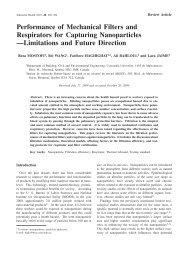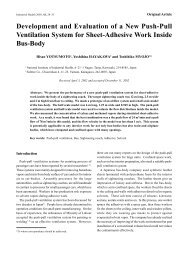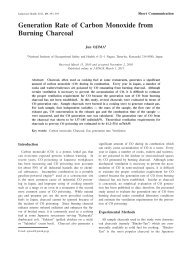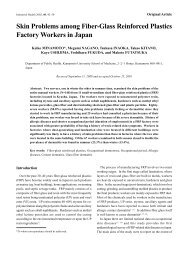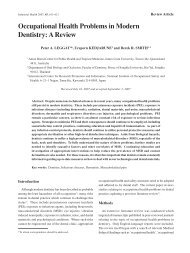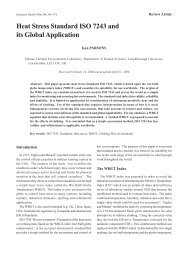Full text [PDF]
Full text [PDF]
Full text [PDF]
You also want an ePaper? Increase the reach of your titles
YUMPU automatically turns print PDFs into web optimized ePapers that Google loves.
Industrial Health 2006, 44, 577–583<br />
Original Article<br />
Cold-Provocation Testing for the Vascular Component<br />
of Hand-Arm Vibration Syndrome in<br />
Health Surveillance<br />
Kerry POOLE*, Joanne ELMS and Howard MASON<br />
Health and Safety Laboratory, Harpur Hill, Buxton, Derbyshire SK17 9JN, UK<br />
Received January 17, 2005 and accepted March 17, 2006<br />
Abstract: The aim was to investigate whether the use of infra-red thermography (I-R) and<br />
measurement of temperature gradients along the finger could improve the diagnostic accuracy of<br />
cold-provocation testing (15°C for 5 min) in vascular hand-arm vibration syndrome (HAVS). Twentyone<br />
controls and 33 individuals with stages 2/3V HAVS were studied. The standard measurement of<br />
time to rewarm by 4°C (T4°C) and temperature gradients between the finger tip, base and middle<br />
(measured using I-R) were calculated. Receiver Operating Characteristics (ROC) analysis to<br />
distinguish between the two groups revealed that for T4°C the area under the ROC curve was not<br />
statistically significantly different from 0.5 (0.64 95% confidence interval 0.49–0.76). The difference<br />
between the tip and middle portion of the finger during the sixth minute of recovery was the most<br />
promising gradient with an area of 0.76 (95% confidence interval 0.62–0.87), and sensitivity and<br />
specificity of 57.6% and 85.7% respectively. However, this was not significantly different from that<br />
for the time to rewarm by 4°C. In conclusion, the cold-provocation test used in this study does not<br />
appear to discriminate between individuals with stage 2/3V HAVS and controls and this is not<br />
improved by the measurement of temperature gradients along the fingers using I-R.<br />
Keywords: Hand-arm vibration, HAVS, Cold-provocation, Diagnosis, Vibration white finger<br />
Introduction<br />
Hand-arm vibration syndrome (HAVS) is a complex<br />
condition with vascular, sensorineural, and musculoskeletal<br />
components affecting workers who handle vibratory tools<br />
extensively. The sensorineural component is characterised<br />
by tingling and numbness in the affected fingers, and reduced<br />
sensitivity to temperature and vibration. The vascular<br />
component manifests itself as periodic blanching of the<br />
affected fingers provoked by cold, loss of sensitivity and<br />
painful throbbing (vibration white finger (VWF)).<br />
Tests designed to assess the vascular component of HAVS<br />
and aid in grading disease severity have focused on measuring<br />
the responsiveness of the digital blood vessels to a cold<br />
*To whom correspondence should be addressed.<br />
stimulus. The most commonly applied test involves immersion<br />
of the hands in cold water for a period of time to elicit coldinduced<br />
vasoconstriction. The recovery of finger skin<br />
temperature following the cold-stimulus is used as a measure<br />
of responsiveness of the digital blood vessels to the cold<br />
stimulus. While there has been many variants of this test 1, 2) ,<br />
the procedure that has been recently used most widely in the<br />
UK involves immersion of the hands in 15°C water for 5 min<br />
and recording of finger skin tip temperature during recovery<br />
using thermocouples 3–5) . However, the diagnostic usefulness<br />
of this technique has been questioned 4, 6, 7) .<br />
Infra-red thermography is an alternative technique that<br />
has been used to measure skin temperature in response to<br />
cold-provocation 8) . The advantage of using such a technique<br />
is that an image of the entire hand can be assessed, which<br />
may potentially yield more information concerning the
578 K POOLE et al.<br />
pattern of rewarming of the whole hand, rather than simply<br />
monitoring the temperature of the finger tip. It may be that<br />
additional information concerning the temperature gradients<br />
along the finger, which can be obtained using infra-red<br />
thermography, is more useful diagnostically. It has been<br />
reported that using infra-red thermography with a water<br />
temperature of 5°C for 1 minute gives a good sensitivity,<br />
specificity, positive predictive value and negative predictive<br />
value for the diagnosis of digital vasospasm 8) .<br />
The aim of this study was to establish whether the<br />
measurement of temperature gradients along the finger using<br />
infra-red thermography aids the diagnostic ability in HAVS<br />
of a cold-provocation test based on a 15°C challenge for 5<br />
min.<br />
Materials and Methods<br />
Subjects<br />
Individuals who attended the HAVS referral centre at the<br />
Health and Safety Laboratory (HSL) between April 2002<br />
and March 2003, had a standard cold-provocation test<br />
performed as part of their assessment, and had been assigned<br />
a Stockholm Workshop staging of 2/3V, were invited to take<br />
part in this study.<br />
Male members of HSL staff who had not been<br />
occupationally exposed to vibration, and after being<br />
interviewed by a medical practitioner to exclude primary<br />
Raynaud’s phenomenon formed the control group. All testing<br />
took place in a temperature controlled laboratory between<br />
the hours of 10am and 4pm.<br />
Ethics committee approval for this study was obtained<br />
from the HSE Research Ethics Committee and informed<br />
consent obtained from each subject.<br />
Procedure<br />
Standard cold-provocation test using thermocouples<br />
When individuals first arrived in the laboratory they were<br />
asked to sit quietly for at least 15 min to adjust to the<br />
laboratory temperature. Thermocouples (Institute of Sound<br />
and Vibration Research, Southampton) were then attached<br />
to the fleshy part of the tips of the four fingers of both hands<br />
using transpore tape. A thin plastic glove was then placed<br />
on each hand and taped loosely at the wrist to exclude air<br />
entrapment. Whilst seated subjects positioned their hands<br />
and forearms at approximately heart level with the palms<br />
facing upwards for 2 min. At the end of this settling period<br />
the subject was instructed to stand up and immerse both<br />
hands up to the wrist crease in water thermostatically<br />
controlled at 15°C for 5 min. Immediately following the<br />
hand-immersion period the subject removed their hands from<br />
the water, the gloves were removed, the subject sat down,<br />
and the hands and forearms were supported at heart level to<br />
rewarm for 10 min. Skin temperatures of the eight fingers<br />
during the settling, hand-immersion and rewarming periods<br />
were recorded on an IBM compatible computer.<br />
Infra-red thermography<br />
Infra-red thermograms of the right hand were taken using<br />
an Infra-red camera (Land Cyclops T135) during the baseline<br />
period before the plastic gloves were placed on the hand<br />
and then every minute during the rewarming period of the<br />
standard cold-provocation test.<br />
Data analysis<br />
For the standard cold-provocation test with thermocouples<br />
the time taken for skin temperature to increase by 4°C<br />
following hand-immersion (T4°C) was calculated for each<br />
finger. On those occasions where a finger failed to rewarm<br />
by 4°C during the rewarming period the time used for<br />
analytical purposes was 600 s, the total duration of the<br />
rewarming period.<br />
For the Infra-red thermograms the following parameters<br />
were calculated for each finger from the baseline image and<br />
for each minute of recovery:<br />
Absolute finger tip temperature<br />
Absolute temperature of the middle of the finger<br />
Absolute temperature of the base of the finger<br />
Gradient (difference) between finger tip and base<br />
temperature (tip-base)<br />
Gradient (difference) between finger tip and middle<br />
temperature (tip-middle)<br />
Gradient (difference) between the middle of the finger<br />
and the base (middle-base)<br />
Statistical analysis<br />
Data for the standard cold-provocation test and infra-red<br />
thermography were plotted to investigate whether they were<br />
normally distributed. Where data appeared to differ<br />
significantly from a normal distribution, non-parametric<br />
statistical tests were used.<br />
Differences between the two groups; cases (stage 2/3V)<br />
and controls for the cold-provocation test were assessed using<br />
the Mann-Whitney U-test (SPSS version 11). Differences<br />
between groups over time for infra-red thermography were<br />
investigated using two-way analysis of variance.<br />
The diagnostic accuracy of either of these tests was<br />
investigated using Receiver Operating Characteristics (ROC)<br />
analysis to establish the optimum outcome metric for<br />
Industrial Health 2006, 44, 577–583
COLD-PROVOCATION TESTING FOR VASCULAR HAVS<br />
579<br />
distinguishing between groups that minimised the false<br />
positive and negative results (MedCalc, version 7.3,<br />
Belgium). The area under the ROC curve was also derived<br />
and tested to determine if this were significantly greater than<br />
0.5 as this would suggest that the diagnostic test has power<br />
to distinguish between the two groups. Sensitivity and<br />
specificity were also defined from the ROC analysis. A<br />
disease prevalence of 40%, similar to that seen in the HAVS<br />
referral centre, was applied to the sensitivity and specificity<br />
data to derive the positive and negative predictive values<br />
for the tests (PPV and NPV respectively).<br />
Results<br />
Twenty-one normal healthy male controls and 33 vascular<br />
HAVS cases, stage 2/3V on the right hand were studied.<br />
The mean (SD) age at time of testing in the two groups was<br />
37.6 (8.4) and 48.2 (7.5) years respectively (p0.05).<br />
The mean (SD) temperature of the finger tip and base in<br />
the laboratory controls in the settling period was 32.2°C<br />
(4.0) and 33.1°C (2.4) respectively, and 31.0°C (4.1) and<br />
31.9°C (3.1) in the HAVS cases. There were no significant<br />
differences (p>0.05) between groups.<br />
Changes in finger tip, middle and base temperatures following<br />
cold-provocation over time were investigated (Fig. 1). Over<br />
time the mean temperature had a tendency to be lower in<br />
the HAVS cases compared to controls. These differences<br />
appeared to get larger as time went on, particularly for the<br />
finger tip. There was a statistically significant difference<br />
between the groups over time but there were no significant<br />
differences at individual time points (p>0.05).<br />
Changes in differential temperatures between finger tip,<br />
middle and base were also investigated (Fig. 2). The mean<br />
difference in temperature between the finger tip and base<br />
was negative to start with in both groups, suggesting that<br />
the base of the finger rewarmed more quickly than the finger<br />
tip. After around 7 min of recovery the mean gradient<br />
reversed in the controls to become positive, showing that<br />
the finger tip was now warmer than the base. However, the<br />
mean gradient remained negative for the HAVS cases for<br />
the duration of the recovery period. These differences were<br />
variable but were found to be significantly different between<br />
groups overall (p0.05), which indicates that the variable<br />
cannot distinguish between groups.<br />
The diagnostic accuracy of the infra-red measurements<br />
for the same challenge was also investigated for each of the<br />
outcome parameters at each time point. The sensitivity,<br />
specificity, PPV, NPV and area under the ROC curve for<br />
the settling period and three time points during recovery<br />
are presented in Tables 1 and 2. For the majority of parameters<br />
at the three time points during recovery the area under the<br />
ROC curve was not found to be significantly different from<br />
0.5, suggesting that these parameters are not able to<br />
distinguish between individuals with stage 2/3V and<br />
laboratory controls. On three occasions the area under the<br />
ROC curve was significantly different from 0.5 (Table 2)<br />
suggesting that these parameters may be useful diagnostically.<br />
There were no significant differences between the areas under<br />
the ROC curve for these three parameters. The parameter<br />
with the greatest area under the curve was the difference in<br />
temperature between the finger tip and the middle part of<br />
the finger at the sixth minute of recovery with an area under<br />
the curve of 0.76, sensitivity of 57.6%, specificity of 85.7%,<br />
PPV of 72.9% and NPV of 75.2%. This area was not
580 K POOLE et al.<br />
Fig. 1. Changes in finger tip, middle and base temperature of the middle finger on the<br />
right hand following cold-provocation.<br />
Each bar represents the mean + 1standard deviation. A presents data for the tip of the middle<br />
finger, B presents data for the middle part of the middle finger, and C presents data for the<br />
basal part of the middle finger. ‘Set’ represents the settling period.<br />
significantly different to that found for T4°C (p=0.143) (Fig.<br />
3).<br />
Discussion<br />
This study has aimed to compare two methods for<br />
measuring recovery of skin temperature following a<br />
standardised cold-provocation in hand-arm vibration<br />
syndrome to investigate which may be the most useful<br />
diagnostically.<br />
Using a cold-provocation test (15°C for 5 min) that has<br />
been most notably used in the DTI scheme for coalminers’<br />
compensation 5) , the median time to rewarm by 4°C increased<br />
in individuals with HAVS stage 2/3V but was not found to<br />
be statistically significantly different from controls. This<br />
specific combination of outcome metric and cold-provocation<br />
has been suggested to be of limited diagnostic value based<br />
on the data from the miners’ compensation scheme 4, 7) . Here<br />
we confirm this measurement did not seem to discriminate<br />
between stage 2/3V HAVS cases drawn from a health<br />
surveillance population and controls.<br />
However, finger rewarming after cold provocation in<br />
various forms has had substantial history of use in<br />
epidemiological HAVS investigations and diagnosis.<br />
Industrial Health 2006, 44, 577–583
COLD-PROVOCATION TESTING FOR VASCULAR HAVS<br />
581<br />
Fig. 2. Differences between the tip, middle and base of the middle finger during recovery<br />
in the three groups.<br />
Each bar represents the mean +1 standard deviation. ‘Set’ represents the settling period.<br />
Table 1. Sensitivity, specificity, positive predictive value and negative predictive value for outcome parameters comparing HAVS<br />
cases and laboratory controls at different times during recovery<br />
0 2 6 10<br />
Sens Spec PPV NPV Sens Spec PPV NPV Sens Spec PPV NPV Sens Spec PPV NPV<br />
Tip 66.7 66.7 57.2 75 18.2 100 100 64.7 72.7 57.1 53 75.8 78.8 61.9 58 81.4<br />
temperature<br />
Middle 69.7 61.9 54.9 75.4 15.2 100 100 63.9 72.7 52.4 50.5 74.2 81.8 52.4 53.4 81.2<br />
temperature<br />
Base 63.6 61.9 52.7 71.8 30.3 85.7 58.6 64.8 75.8 52.4 51.5 76.5 60.6 71.4 58.6 73.1<br />
temperature<br />
Tip-base 97 19 44.4 90.5 87.9 23.8 43.5 74.7 78.8 47.6 50.1 77.1 72.7 52.4 50.5 74.2<br />
Tip-middle 30.3 85.7 58.6 64.8 27.3 95.2 79.1 66.3 57.6 85.7 72.9 75.2 27.3 90.5 65.7 65.1<br />
Middle-base 100 19 45.2 100 30.3 90.5 68 66.1 84.8 33.3 45.9 76.7 72.7 66.7 59.3 78.6<br />
Sens relates to sensitivity, Spec relates to specificity, PPV relates to positive predictive value and NPV relates to negative predictive value.
582 K POOLE et al.<br />
Table 2. Area below ROC curve (95% confidence interval) for each parameter at<br />
different time points comparing stage 2/3V and laboratory controls middle finger<br />
right hand<br />
Time (min)<br />
Parameter 0 2 6 10<br />
Tip 0.62 0.55 0.65 0.63<br />
temperature (0.47, 0.75) (0.41, 0.68) (0.50, 0.77) (0.49, 0.76)<br />
Middle 0.62 0.49 0.57 0.59<br />
temperature (0.48, 0.75) (0.35, 0.63) (0.42, 0.70) (0.44, 0.72)<br />
Base 0.63 0.51 0.62 0.65*<br />
temperature (0.49, 0.76) (0.37, 0.65) (0.48, 0.75) (0.51, 0.78)<br />
Tip-base 0.5 0.50 0.62 0.64<br />
(0.36, 0.64) (0.36, 0.64) (0.47, 0.74) (0.49, 0.79)<br />
Tip-middle 0.54 0.57 0.76* 0.53<br />
(0.40, 0.67) (0.43, 0.71) (0.62, 0.87) (0.39, 0.67)<br />
Middle-base 0.54 0.56 0.53 0.66*<br />
(0.40, 0.68) (0.42, 0.70) (0.39, 0.66) (0.52, 0.78)<br />
*Area under ROC curve significantly different from 0.5, p
COLD-PROVOCATION TESTING FOR VASCULAR HAVS<br />
583<br />
and abnormal was the difference between finger tip and<br />
middle at the sixth minute of rewarming. However, these<br />
results were derived from multiple comparisons and the<br />
chance that this is a spurious result cannot be ruled out. The<br />
sensitivity, specificity, PPV and NPV for this parameter were<br />
calculated as 57.6%, 85.7%, 72.9% and 75.2%, which in<br />
themselves do not indicate a diagnostically powerful test.<br />
The results suggested that infra-red thermography and<br />
measurement of more complex temperature gradients along<br />
the finger does not necessarily improve the diagnostic power<br />
over the use of single point thermocouple. The present study<br />
is larger than Coughlin’s study and therefore it seems unlikely<br />
that the number of subjects could account for the differences<br />
between the two studies. It remains unclear whether the<br />
nature of the cold provocation, Coughlin’s being shorter and<br />
more severe a challenge, could have contributed to these<br />
differences in diagnostic power.<br />
We have considered possible biases in our study that may<br />
have led to poorer diagnostic outcomes for the coldprovocation<br />
test. Mis-classification of cases appears unlikely;<br />
individuals were assigned to this group after a prior full HAVS<br />
assessment 5) as part of health surveillance rather than within<br />
a medicolegal con<strong>text</strong>. Prior to testing these individuals<br />
underwent a repeat of the symptom questionnaire of this<br />
assessment to confirm their staging. It is understood that<br />
laboratory controls may not reflect workers undertaking<br />
manual activity, but this may be expected to exaggerate any<br />
group differences if it has any influence at all. However,<br />
these volunteers were assessed by a physician for likely<br />
confounding influences and were unlikely (because of their<br />
positive attitude to research) to with-hold or misrepresent<br />
any relevant medical or familial conditions. Overall we do<br />
not believe that miss-classification of subjects is an issue<br />
within the study.<br />
Using the test conditions applied in this study there is<br />
little evidence that this cold-provocation test (15°C for 5<br />
min) using thermocouples or infra-red thermography is a<br />
useful diagnostic test for vascular HAVS. A single infrared<br />
thermography metric out of many comparisons was more<br />
diagnostically useful while using the same cold provocation<br />
but only when based on a ratio of temperature measurements<br />
at a highly specific time point. This needs to be confirmed.<br />
The data does not exclude the diagnostic use of thermography<br />
(or thermocouples) to measure rewarming in some form,<br />
but the nature of the cold challenge or the simplistic use of<br />
a single outcome metric is not appropriate.<br />
References<br />
1) Harada N (2002) Cold-stress tests involving finger skin<br />
temperature measurement for evaluation of vascular disorders<br />
in hand-arm vibration syndrome: review of the literature.<br />
Int Arch Occup Environ Health 75, 14–9.<br />
2) Lindsell C, Griffin M, Health Safety Executive (1998)<br />
Standardised diagnostic methods for assessing components<br />
of the hand-arm vibration syndrome, HSE Books, Suffolk.<br />
3) Lindsell CJ,Griffin MJ (1997) Standardised diagnostic<br />
methods for assessing components of the hand-arm vibration<br />
syndrome. HSE contract research report, Southampton.<br />
4) Proud G, Burke FD, Lawson IJ, McGeoch KL, Miles JN<br />
(2003) Cold provocation testing and hand-arm vibration<br />
syndrome—audit of the results of the Department of Trade<br />
and Industry scheme for the evaluation of miners. Brit J Surg<br />
90, 1076–9.<br />
5) Lawson I, McGeoch KL (2003) A medical assessment process<br />
for a large volume of medico-legal compensation claims for<br />
hand-arm vibration syndrome. Occup Med 53, 302–8.<br />
6) McGeoch K, Gilmour W (2000) Cross sectional study of a<br />
workforce exposed to hand-arm vibration [HAV]: with<br />
objective tests and the Stockholm workshop scales. Occup<br />
Environ Med 57, 35–42.<br />
7) Mason HJ, Poole K, Saxton J (2003) A critique of a UK<br />
standardized test of finger rewarming after cold provocation<br />
in the diagnosis and staging of hand-arm vibration syndrome.<br />
Occup Med 53, 325–30.<br />
8) Coughlin P, Chetter I (2001) The analysis of sensitivity,<br />
specificity, positive predictive value and negative predictive<br />
value of cold provocation thermography in the objective<br />
diagnosis of the hand-arm vibration syndrome. Occup Med<br />
51, 75–80.<br />
9) Griffin M (1990) Handbook of human vibration. Academic<br />
Press, London.


![Full text [PDF]](https://img.yumpu.com/23679865/1/500x640/full-text-pdf.jpg)
![Full text [PDF]](https://img.yumpu.com/23679861/1/190x253/full-text-pdf.jpg?quality=85)

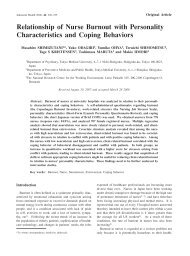
![平成19年度特定調達品目調達実績取りまとめ表[pdf] - 労働安全衛生 ...](https://img.yumpu.com/23679818/1/190x135/19pdf-.jpg?quality=85)
